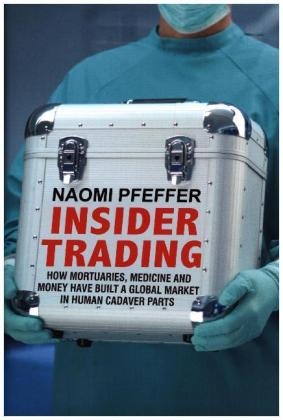
Insider Trading
How Mortuaries, Medicine and Money Have Built a Global Market in Human Cadaver Parts
Seiten
2017
Yale University Press (Verlag)
978-0-300-11855-1 (ISBN)
Yale University Press (Verlag)
978-0-300-11855-1 (ISBN)
- Titel ist leider vergriffen;
keine Neuauflage - Artikel merken
The cadaver industry in Britain and the United States, its processes and profits
Except for organ transplantation little is known about the variety of stuff extracted from corpses and repurposed for medicine. A single body might be disassembled to provide hundreds of products for the millions of medical treatments performed each year. Cadaver skin can be used in wound dressings, corneas used to restore sight. Parts may even be used for aesthetic enhancement, such as liquefied skin injections to smooth wrinkles.
This book is a history of the nameless corpses from which cadaver stuff is extracted and the entities involved in removing, processing, and distributing it. Pfeffer goes behind the mortuary door to reveal the technical, imaginative, and sometimes underhanded practices that have facilitated the global industry of transforming human fragments into branded convenience products. The dead have no need of cash, but money changes hands at every link of the supply chain. This book refocuses attention away from individual altruism and onto professional and corporate ethics.
Except for organ transplantation little is known about the variety of stuff extracted from corpses and repurposed for medicine. A single body might be disassembled to provide hundreds of products for the millions of medical treatments performed each year. Cadaver skin can be used in wound dressings, corneas used to restore sight. Parts may even be used for aesthetic enhancement, such as liquefied skin injections to smooth wrinkles.
This book is a history of the nameless corpses from which cadaver stuff is extracted and the entities involved in removing, processing, and distributing it. Pfeffer goes behind the mortuary door to reveal the technical, imaginative, and sometimes underhanded practices that have facilitated the global industry of transforming human fragments into branded convenience products. The dead have no need of cash, but money changes hands at every link of the supply chain. This book refocuses attention away from individual altruism and onto professional and corporate ethics.
Naomi Pfeffer is author of The Stork and the Syringe: A Political History of Reproductive Medicine and an associate of University College London. She lives in London.
| Erscheinungsdatum | 19.09.2016 |
|---|---|
| Zusatzinfo | 20 figs. |
| Sprache | englisch |
| Maße | 156 x 235 mm |
| Gewicht | 816 g |
| Themenwelt | Medizin / Pharmazie ► Medizinische Fachgebiete ► Medizinethik |
| Studium ► Querschnittsbereiche ► Geschichte / Ethik der Medizin | |
| Studium ► Querschnittsbereiche ► Prävention / Gesundheitsförderung | |
| Naturwissenschaften ► Biologie ► Humanbiologie | |
| Sozialwissenschaften ► Soziologie | |
| ISBN-10 | 0-300-11855-4 / 0300118554 |
| ISBN-13 | 978-0-300-11855-1 / 9780300118551 |
| Zustand | Neuware |
| Haben Sie eine Frage zum Produkt? |
Mehr entdecken
aus dem Bereich
aus dem Bereich
Die Geschichte eines Weltzentrums der Medizin von 1710 bis zur …
Buch | Softcover (2021)
Lehmanns Media (Verlag)
17,95 €
von der Antike bis zur Gegenwart
Buch | Softcover (2024)
C.H.Beck (Verlag)
12,00 €
Krankheitslehren, Irrwege, Behandlungsformen
Buch | Softcover (2024)
C.H.Beck (Verlag)
39,95 €


